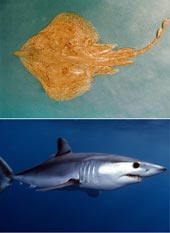|
|
James Owen
for National Geographic News
November 16, 2007The great white shark is among 30 species of sharks and rays fast swimming toward oblivion in the Mediterranean Sea, a new report warns.
The newly published World Conservation Union (IUCN) report identifies the waters between Europe and Africa as having the highest percentage of threatened sharks and rays in the world.

Some 42 percent of Mediterranean species are at risk, says the IUCN Red List assessment, performed by the conservation body's Shark Specialist Group.
The group blames the plummeting populations on habitat degradation, sport angling, human disturbance, and overfishing—including fish caught as unintended bycatch. (Related: 8 Million Sharks Killed Accidentally off Africa Yearly [April 17, 2007].)
"Our analyses reveal the Mediterranean Sea as one of the world's most dangerous places on Earth for sharks and rays," Claudine Gibson, IUCN Shark Specialist Group program officer and co-author of the report, said in a statement.
"Bottom-dwelling species appear to be at greatest risk in this region, due mainly to intense fishing of the seabed."
A total of 71 species were assessed. Of the 30 species deemed threatened with extinction, 13 were classified as critically endangered, 8 as endangered, and 9 as vulnerable.
Only ten species (14 percent) were considered free of any extinction risk.
Almost Gone
Critically endangered species include the seabed-hugging Maltese skate (Leucoraja melitensis), which lives only in the Mediterranean. Bottom-trawl fishing is the main cause of recent population declines of 80 percent, the IUCN report says.
The shortfin mako shark (Isurus oxyrinchus) and porbeagle shark (Lamna nasus), both prized for their meat and fins, were likewise found to be critically endangered.
"We are particularly concerned about the porbeagle and mako sharks," said shark expert Alen Soldo of the University of Split, Croatia, who participated in the study. "Our studies reveal persistent fishing pressure well in excess of the reproductive capacity of the species."
Endangered species include the giant devil ray (Mobula mobular), which is confined mainly to the Mediterranean.
Its large size and low reproduction rate—females can grow to 17 feet (5 meters) and give birth to only one pup per pregnancy—make the ray especially vulnerable to fishing pressure, the new report warns. |
|